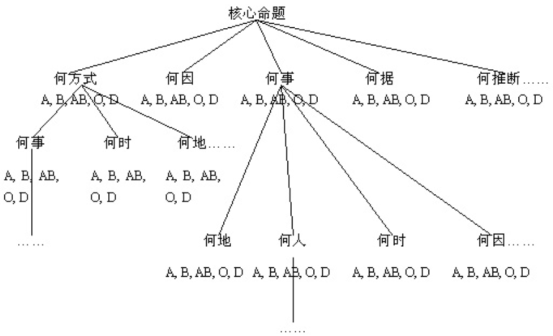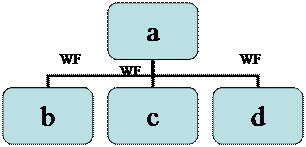Analysis of Discourse Information
Du (2007) initiated the discourse information studies on legal discourse. According to Du, there is one core proposition in a discourse. Under this core proposition, the whole discourse can be analyzed into different information units, which mainly contain 15 Ws. They are What Thing, (WT), What Basis (WB), What Fact (WF), What Inference (WI), What Disposal (WP),Who (WO), When (WN), Where (WR), How (HW), Why (WY), What Effect (WE),What Condition (WC), What Attitude (WA), What Change (WG) and What Judgment(WJ), etc.
The model defines the term “information” as a proposition with a relatively complete structure, which is a minimal meaning unit for communication. He considers “information” as countable, which is different from other approaches. The information in a discourse is woven into a network in which the information in different parts relates to each other and bears such relations as primary and secondary, upper and lower, former and latter, etc. The discourse information structure model is original with a series of manipulating parameters, which is totally different from discourse structure model proposed by other researchers that emphasize grammar and language, but neglect the communicative facets.
According to the tree information model (Du, 2007), any legal discourse is a hierarchical network where discourse is centered on a kernel proposition that is further developed by detailed information at subordinate levels. Thus, the discourse information network can be described as a tree structure. The kernel proposition is posited on the top level and developed by detailed information units below, which in turn may further be developed by information units, the minimal meaningful unit for communication, at the next lower level. The lines link the kernel proposition with information units, and information units with lower-level information units represent their relationships, which are termed as information knots. Discourse information structure is composed of information units each of which functions as the smallest meaning unit based on proposition. Information units relate to each other and each develops its immediate super-ordinate information unit from a certain aspect.
As the subordinates, information units b and c explain the cause of information unit a. Besides “reason”, there are some other relations between information units which can be expressed by means of interrogative words. Generally speaking, the content of an information unit can be expressed by interrogative words, such as What Thing (WT), What Basis (WB), What Fact (WF), What Inference (WI), What Disposal (WP),Who (WO), When (WN), Where (WR), How (HW), Why (WY), What Effect (WE),What Condition (WC), What Attitude (WA), What Change (WG) and What Judgment (WJ), etc. The interrogative words actually denote from what aspect subordinate information units specify their superordinate ones.

Here are some examples which show the application of DIA(Discourse Information Analysis)
Example 1
Knowledge often results only after persistent investigation. Einstein, after a lengthy examination of the characteristics of matter and energy, formulated his famous Theory of Relativity. Using plaster casts of footprints, fingerprints, and stray strands of hair, a detective pursues the criminal. Investigations into the causes of polio have provided us with the means for prevention and cure of this dreaded disease only after many years of research.
Earl Rudolph
In this paragraph, each information unit is labeled as a, b, c, d in sequence. The structure of this paragraph can be expressed in a tree model.

The relation between information unit a and its subordinate information unit b, c, d, is termed as information knot. Here in this case, the information knot is categorized as WF( what fact).
Example 2:
A: <WY> Why are you late?
B: <WY> My clock doesn’t work. <WF> I have just bought it for 3 days.
A:< WT> Don’t say anything unrelated.
Example 3:
A: <WN> When did you left home?
B: <WN> Three days ago.
Example 4:
A: <WR> Where do you live?
B: <WR>Guangzhou
Example 5:
A: <WO> Who stole the handbag?
B: <WO> Bill Wilkins
Example 6:
<WI> She was at home yesterday, so she must have met Mr Smith
Example 7:
<WC> Children under 7 are not allowed to stay at home alone.
Example 8:
<WB> He becomes the heir of the big fortune according to the law.
Example 9
A:<HW> How did you get to the bus station?
B: <HW> On foot
Example 10
<WP> Since you have parked your car in the forbidden areas, you will get the parking ticket soon.
Example 11
A: <WA> Do you have any doubt about this decision?
B: <WA> No.
Example 12
A: <WE> What change will this policy bring to us?
B: <WE> We can have more time to stay with our family.
Example 13
<WG> She invited us to the dinner. At dinner, she answered a call and then she left.
Example 14
<WJ> Based on the evidence you offer, the conclusion is very obvious that the murder is her brother.
